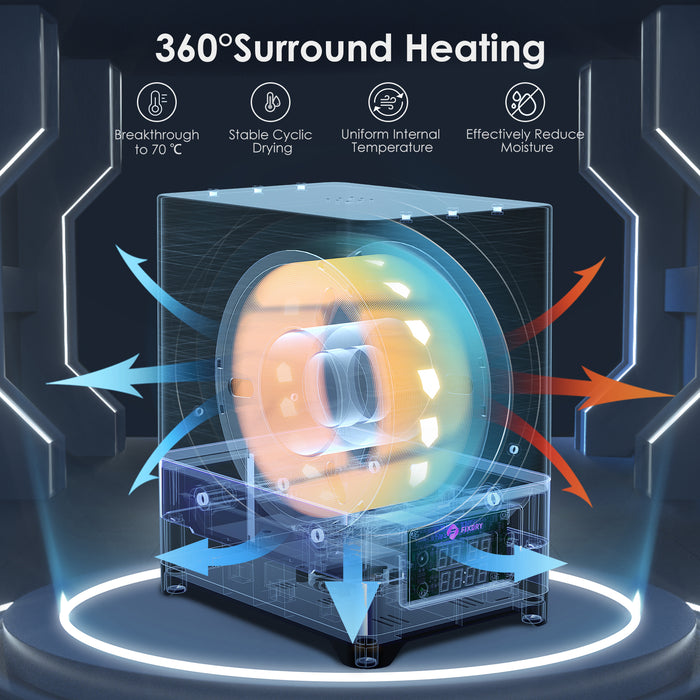
A Comprehensive Guide to 3D Printing: Flexible 3D Printer Filament and the Best Filament Dryer
3D printing has revolutionized the manufacturing and design industries, allowing for rapid prototyping and the creation of complex structures with ease. Whether you are a hobbyist or a professional, understanding the intricacies of 3D printing materials and accessories is crucial. Two essential components for successful 3D printing are flexible 3D printer filament and the best filament dryer. These elements ensure high-quality prints and a smoother printing experience.
This guide will delve into the importance of flexible 3D printer filament and the best filament dryer, referencing key insights from Sunlu’s comprehensive article on navigating the 3D printing market. By understanding these components, you can enhance your 3D printing projects and achieve optimal results.
Choosing the Right Flexible 3D Printer Filament
FIXDRY 3D Filament 2 Spool Compatible Dryerbox DOUBLE-NT1
Choosing the right filament is the first step toward achieving the best results in your 3D printing projects. Flexible 3D printer filament, such as Thermoplastic Polyurethane (TPU), offers unique advantages over traditional rigid filaments. TPU is known for its elasticity, making it ideal for printing objects that require flexibility and durability, such as phone cases, toys, and wearable items.
Flexible 3D printer filament comes in various grades, each with distinct properties. For instance, some filaments offer higher elasticity, while others provide increased resistance to wear and tear. When selecting a flexible 3D printer filament, consider factors such as shore hardness, which measures the material’s resistance to indentation, and tensile strength, which indicates how much stress the filament can withstand before breaking.
Importance of the Best Filament Dryer

Moisture is the enemy of 3D printing filaments. Even the highest quality flexible 3D printer filament can absorb moisture from the air, leading to poor print quality, such as bubbles, stringing, and weak layers. This is where the best filament dryer comes into play. A filament dryer ensures that your filament remains dry, maintaining its optimal printing properties.
The best filament dryer works by heating the filament to a specific temperature, driving out any absorbed moisture. This process is crucial for filaments like TPU, which are particularly hygroscopic. Investing in the best filament dryer can significantly improve your print quality, reduce waste, and save you time and frustration in the long run.
Setting Up Your 3D Printing Environment

Creating an optimal 3D printing environment is essential for successful prints. Alongside selecting a high-quality flexible 3D printer filament and the best filament dryer, consider the following setup tips:
- Stable Platform: Ensure your 3D printer is placed on a stable and level surface to prevent vibrations and movement during printing.
- Temperature Control: Maintain a consistent room temperature to avoid fluctuations that could affect the printing process.
- Ventilation: Proper ventilation is crucial to dissipate any fumes generated during printing, especially when using flexible 3D printer filament.
- Filament Storage: Store your filaments in a dry, airtight container to prevent moisture absorption. Using the best filament dryer before printing can further ensure filament quality.
Common Issues and Troubleshooting
Even with the best equipment and materials, issues can arise during 3D printing. Understanding common problems and how to troubleshoot them is vital. Here are some frequent issues associated with flexible 3D printer filament and tips to resolve them:
- Stringing: This occurs when thin strands of filament are left between printed sections. To reduce stringing, adjust the retraction settings and ensure your filament is dry using the best filament dryer.
- Poor Adhesion: Flexible filaments may have difficulty adhering to the print bed. To improve adhesion, use a heated bed, apply a suitable adhesive, or use a specialized print surface designed for flexible materials.
- Clogging: Flexible filaments can sometimes clog the extruder. Ensure the extruder temperature is appropriate for the filament type and consider using an all-metal hotend to handle the higher temperatures required.
Enhancing Print Quality with the Best Practices
Achieving high-quality prints with flexible 3D printer filament involves a combination of the right equipment, proper settings, and best practices. Here are some tips to enhance your print quality:
- Print Speed: Flexible filaments typically require slower print speeds to ensure accuracy and prevent issues like under-extrusion.
- Layer Height: Adjust the layer height to find a balance between print quality and time. Finer layers result in smoother prints but take longer to complete.
- Extrusion Temperature: Follow the manufacturer's recommended extrusion temperature for the flexible 3D printer filament you are using. Experiment within the recommended range to find the optimal setting for your specific printer.
- Use of Support Structures: When printing complex shapes, support structures can help maintain the integrity of your print. Ensure supports are easily removable and do not damage the print surface.
Key Takeaways
- Flexible 3D Printer Filament: Offers unique advantages for printing objects that require elasticity and durability. Consider properties such as shore hardness and tensile strength when selecting a filament.
- Best Filament Dryer: Essential for maintaining filament quality by removing moisture. This leads to better print quality and reduces issues like stringing and weak layers.
- Optimal Environment: A stable platform, consistent temperature, and proper ventilation are crucial for successful 3D printing.
- Troubleshooting: Understanding common issues and how to resolve them ensures smoother printing experiences.
- Best Practices: Adjusting print speed, layer height, and extrusion temperature, along with using support structures, enhances print quality.
Conclusion
3D printing is an exciting and versatile technology, offering endless possibilities for creativity and innovation. By understanding the importance of flexible 3D printer filament and investing in the best filament dryer, you can significantly enhance your 3D printing projects. Following best practices and maintaining an optimal printing environment will ensure high-quality prints and a more enjoyable printing experience. Whether you are a novice or an experienced printer, these insights will help you navigate the complexities of 3D printing and achieve the best results possible.

